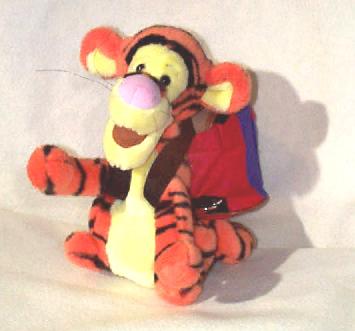
The systems, sensors, and behaviors at work in the Affective Tigger are customized to both the Disney version of Tigger's personality, and to one particular stuffed animal. One could not, for example, take out the workings and put them into say a Smurf and expect it to make sense. For one thing, a Smurf doesn't bounce like a happy Tigger does. A Smurf would express happiness in ways wholly different from Tigger, depending on which Smurf was chosen.
There are dozens of stuffed Tigger dolls available on the toy store shelves today. From plain old plush toys, to mechanical springy toys, to fully automated bouncing Tiggers. From the gamut of choices, a single animal was chosen for its expressivity, size, and weight. The chosen toy was a readily available Disney store variation of Tigger, with big ears, and a long tail.
To study the impact of the chosen Tigger shape, three female and one male child, aged five to thirteen years, were asked to play with the unaltered stuffed Tigger. In the course of their play, the children were asked to `make Tigger look happy' as well as sad. From observing these play sessions, several interesting features were identified as potentially emotionally relevant. The most prominent feature to their play was the availability of the ears. This Disney doll has especially large ears and the children immediately grabbed and pulled on them when asked to make Tigger look happy or sad. Tigger's mouth was the secondary feature of interest: the children closed it to make him look sad, and let it spring back open when he was happy. One child mimed the action of opening and closing a zipper over Tigger's mouth. The association of mouth with the distinction of happy and sad is corroborated by the research of Field (et. all, 1992) who noted that infants looked primarily at the mouth for happy and sad expressions. One child specifically bent Tigger's head forward in response to my request to make the Affective Tigger look sad. Three of the children bounced the Affective Tigger to express happiness.
Voice was another compelling feature, laden with emotional information and expressivity. Although it was not available in the preliminary studies, the children in the main study have been extremely responsive to the vocalizations of the Affective Tigger. They all seem to expect a toy to speak, even if that utterance is complete nonsense.
Once the play sessions were underway, children repeatedly asked me for more interaction from the Affective Tigger. Specifically, they want to make him happy when they clap his hands together, and sad when they pull on his whiskers. A child who can reason well enough to ask questions like these, is indeed projecting feelings onto his/her toy, and has an understanding of the causes for various emotions.